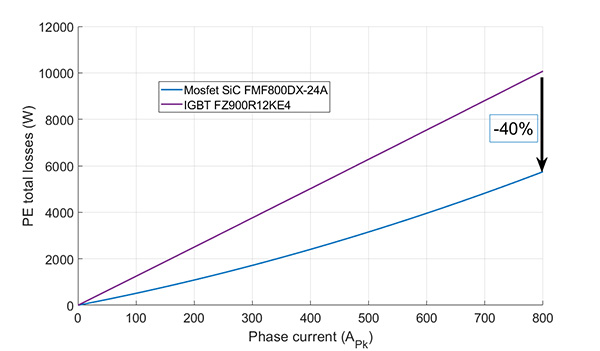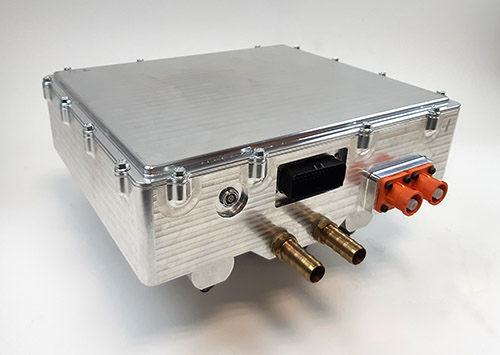In the case of electrified vehicles, whether battery-powered (electric or hybrid) or powered by fuel cells (FC), power electronics (PE) converters play a major role, as they are used for a variety of functions. For example, they are used to drive electric motors, manage on-board energy or control traction battery recharging.
PE refers to an electronic system for converting electrical energy by switching semiconductor transistors, for which silicon (Si) is the historic and still widely used material. But in recent years, the breakthrough of new, more sophisticated transistors, particularly made from materials such as silicon carbide (SiC) and gallium nitride (GaN), has turned the power component market upside down, as their performance surpasses that of their Si-based counterparts.
These new materials, known as "wide band gaps" (WBG1) , offer excellent performance in terms of efficiency, power density and switching speed, with a beneficial impact on power losses (figure 1).

However, this technological breakthrough brings with it new challenges that the “Mobility & Systems” Division is seeking to meet through research work at a wide range of maturity levels, as part of partnership projects or through doctoral theses.
PE-related research areas include:
- understanding and characterizing WBG components in a system environment: this area aims to characterize WBG components with a view to enriching the models used to study them within an electrical system [1]. To this end, IFPEN has entered into a partnership with the company CGD (Cambridge GaN Devices) to understand the impact of implementing these new technologies in converters, and to model the parasitic effects, which can have a major impact on the performance of electrical converters, or even lead to their deterioration. A complementary objective is to develop new test methods dedicated to WBGs, taking into account increasingly severe mission profiles, in order to assess their reliability as well as their fault mechanisms;
- power converters and innovative topologies: in this area, IFPEN is involved in the development of new architectures aimed at exploring the efficiency of WBG components to increase the mass and volume power densities of converters and meet increasingly stringent electronic durability requirements. In this context, traction inverter solutions2 [1] based on silicon carbide (SiC) components have been developed (figure 2). IFPEN is also contributing to research into new power conversion architectures for the hybridization of battery/FC systems [2] in the field of heavy transport, and is involved in the development of prototype solutions for driving electrified compressors that supply air to fuel cells [3] ;
- thermal management and new cooling solutions: converters based on Si components are generally cooled indirectly via a "water plate" type heatsink. However, using WBG components to their full potential can generate local power losses of the order of 1 kW/cm2, i.e. ten times greater than those of Si chips. IFPEN is therefore exploring new localized cooling solutions for the semiconductor chip, while notably focusing on a better understanding of the thermal behaviour of components implemented within electronic boards. The aim is to derive a model capable of better predicting the junction temperatures of WBG components, as these cannot generally be measured directly.

All of this ongoing work on PE is aimed at improving the performance and reliability of the energy conversion systems that implement the latest-generation transistors, in order to exploit their full benefits in the context of vehicle electrification.
1- Wide Band Gap.
2- Energy conversion unit that drives the electric motor of an electrified vehicle from a DC voltage source such as the traction battery.
Bibliographic references
-
A. Battiston, L. Kefsi, M. Milosavljevic, A. Sabrie, High-Power / High-Voltage (250 kW / 750V) SiC-Based Inverter for Electric Vehicles Applications, 2021 23rd European Conference on Power Electronics and Applications (EPE'21 ECCE Europe), pp. 1-10, 2021.
>> https://doi.org/10.23919/EPE21ECCEEurope50061.2021.9570699
-
Alexandre Battiston, Electric energy converter capable of being connected to two power supplies and capable of recovering energy (Convertisseur d’énergie électrique apte à être connecté à deux sources d’alimentation et apte à la récupération d’énergie), Invention patent FR3129544 (A1), Nov. 25, 2021.
>> https://worldwide.espacenet.com/patent/search/family/080225320/publication/FR3129544A1?q=FR3129544
-
F. D. De Sousa, A. Battiston, S. Pierfederic, F. Meibody-Tabar, Evaluation of the Magnetic Behavior of a Single Pole Pair Fe-Cr-Co-based Memory Motor Considering a Standstill Magnetization: Electrified Compressor Applications, IEEE Transactions on Magnetics.
>> https://doi.org/10.1109/TMAG.2022.3141895
Scientific contact : alexandre.battiston@ifpen.fr





